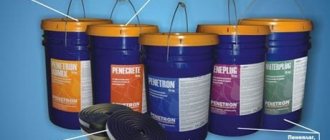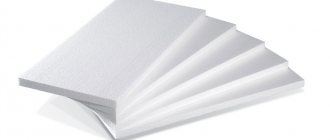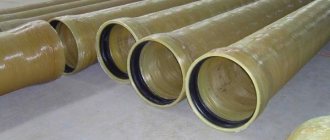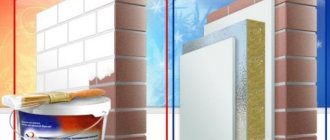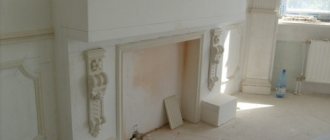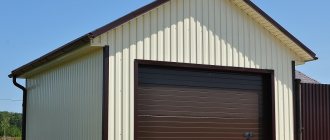In order to process metal structures that can become very hot, heat-resistant paints are used. They are used to paint the surfaces of stoves, boilers, radiators, barbecues and other objects.
Heat-resistant paint in cans has a number of features compared to conventional paints and varnishes; it has quite specific characteristics and qualities. Sometimes thermal paints are used for purposes other than those stated by the manufacturer, but this leads to unnecessary costs and poor-quality results.
Features of aerosols
Producing paint in cans is a very successful decision by the manufacturer, since it is this fact that allows you to evenly paint all kinds of cracks and hard-to-reach gaps.
When choosing heat-resistant aerosol paint, you should pay attention to the characteristics, which may also influence the purchasing decision.
The main thing you should focus on is the maximum temperature for which this product is designed. Heat-resistant aerosol paint can withstand only a certain temperature regime, which is indicated by the manufacturer on the can.
In stores you can find a considerable amount of heat-resistant metal paints that are not designed for direct contact with fire. One should also distinguish between constant heating and short-term heating. The constant heating temperature is usually noticeably lower.
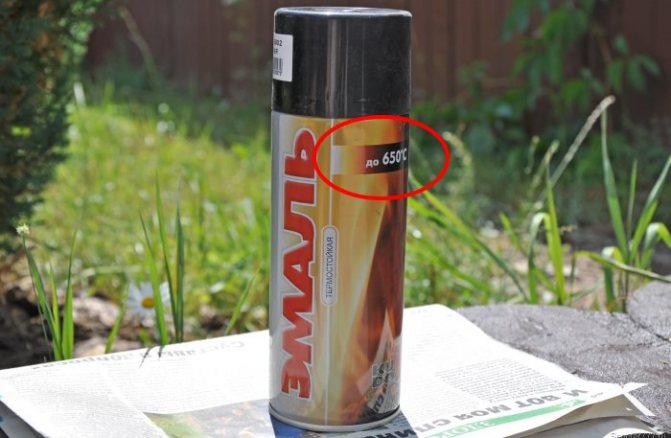
There are certain requirements for the surface to be coated. Sometimes, for a high-quality result, before painting it should be primed, then apply heat-resistant spray paint, holding the can at a distance of about 25 cm from the surface and shaking occasionally.
Priming will prevent peeling of the top enamel due to exposure to high temperatures.
However, some brands do not require a primer. This is indicated in the instructions, so before using any paint, you must carefully study the manufacturer's recommendations.
For example, the instructions for heat-resistant enamel in the High Heat can say: “it is not recommended to prime the surface.” You just need to clean it of the old paint layer and rust, wash it with soapy water and dry it, or clean it with sandpaper and degrease it with a solvent.
If you have any doubts about the method of using the spray can, you can clarify all questions with your sales consultant or distributor. Most companies provide online consultations.
Heat-resistant paints retain increased ductility even after complete drying. When in contact with fire, a painted metal surface can increase or expand, and its plasticity allows the applied layer to be maintained in its original state without peeling or delamination.
Painting a brick oven
Peculiarities
The photo shows what the painted stove looks like.
The operation of furnace equipment occurs at elevated and extreme temperatures, and this imposes a number of specific requirements on finishing materials:
- The coating must consist of refractory, non-flammable components that retain their properties at high temperatures;
- The finish must withstand significant temperature changes, because the difference between the heated and cold surface of the oven can be very significant;
- The material from which the stove is made undergoes noticeable thermal expansion during its operation, so the finishing coating must be sufficiently elastic to neutralize these changes in the geometry of the structure;
- The surface of the coating should radiate heat well. It is known that radiation in the infrared frequency range occurs most actively with dark colors; moreover, matte and rough surfaces transfer heat better;
- The paint or varnish should not contain components that, when heated, will release harmful compounds and toxins into the atmosphere. Solvents contained in heat-resistant enamels must quickly and completely evaporate, and paints must be prepared on the basis of water or non-toxic solvents;
- Coatings for metal parts must withstand high temperatures - from 600 degrees and above.
A special operating mode imposes specific requirements.
Materials
It is important to correctly determine how to paint a brick stove.
To treat brick kilns, you can use several types of coatings, which combine heat resistance, non-flammability and toxicological safety:
- Silicate paint. It is characterized by heat resistance, as it is prepared on the basis of liquid glass and mineral pigments and fillers. It is applied with a brush and does not require high professionalism during application;
- Acrylic water-dispersion paint. It is prepared on the basis of water and acrylic dispersion, which makes it indifferent to temperature conditions. The distinctive features of this material are its relatively high price and wide selection of colors, as well as good elasticity and durability;
- Organosilicon enamels and varnishes. They are the most resistant to high temperatures and quite reliable materials. They have a thick consistency that requires dilution;
- Fireproof paints and thermovarnishes for metal parts. Most often they are produced in the form of sprays and are able to withstand the temperatures of an open flame and the red heat of steel. May contain silicone resins and aluminum shavings for shine.
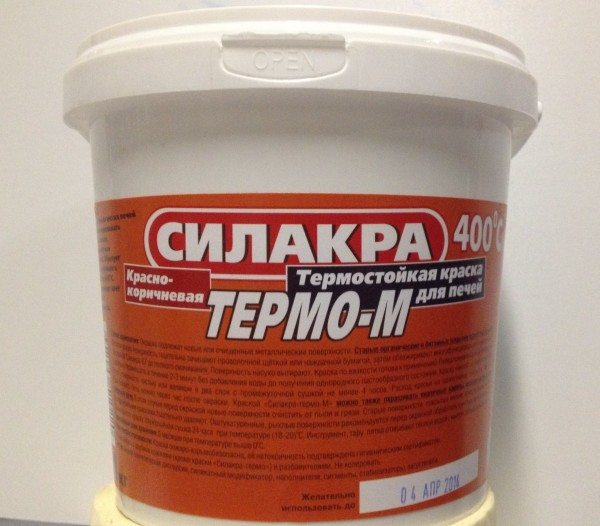
Silicate paint can withstand heat up to 400 degrees.
In addition, there are various impregnations and primers that cannot be called paints, since they do not change color and do not create a film on the surface, but at the same time these compounds are absorbed into the material and maintain it in an acceptable condition when the brick has a wet tint and seems washed .
Impregnating compounds can be used.
If you are not afraid of the high cost, use acrylic water-based paint, as this paint is absolutely harmless and lasts for a long time without changing shade. The choice of colors and their quality has no competitors among other types of finishing paint.
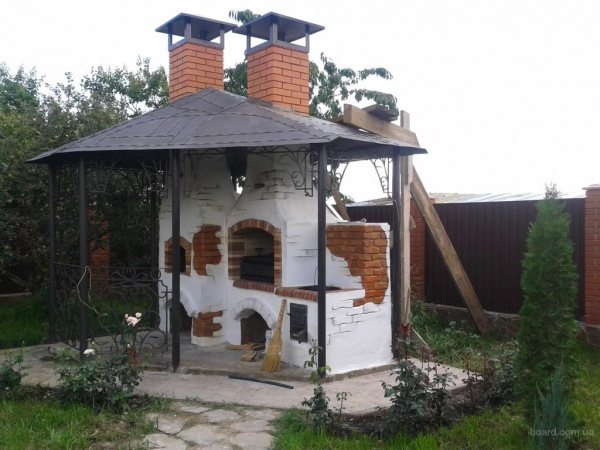
But furnace equipment specialists most often use silicone enamels of the KO-85, KO-168, KO-174, KO-813, KO-835A and KO-1112 brands.
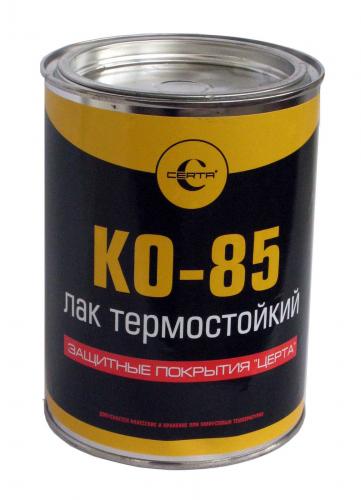
An excellent product for finishing a brick oven.
These compounds can withstand heating up to 600 degrees and are intended for finishing stoves, chimneys, fireplaces, etc., so they are perfectly suitable for our purposes. The coating can be made transparent or matte, and you can also add color to it. Transparent coatings are most often used, as they preserve the beauty of the masonry.
Paints and varnishes intended for painting stoves and fireplaces must withstand temperatures of at least 300-400˚C. Most containers with heat-resistant compounds indicate that they are able to withstand temperatures of 600-750˚C, which is, in principle, sufficient for a regular home oven.
The simplest solution is to purchase special heat-resistant paint for stoves and barbecues at any hardware store. However, such a specific paint and varnish material is often sold at an inflated price, since marketers believe that if a person has the funds to create and maintain a stove or fireplace, then he is able to buy an expensive heat-resistant composition.
But even wealthy people want to save money and therefore can resort to alternative means - some of the most common paints are able to withstand high temperatures. For example, you can paint the stove with simple enamel or oil paint, but if the paint material contains drying oil, then over time the coating will darken.
For example, you need to paint a stove made of brick, one side of which goes outside, the other is inside the room. In this case, you will need to use two or even three types of paint, since paintwork materials intended for indoor use will quickly crack and become unusable on the outside, and therefore it is necessary to coat it with a heat-resistant composition with increased anti-corrosion characteristics.
Painting the outer surface of a brick sauna stove does not require high heat resistance. The surface rarely heats up above 70-80°C. Except that near the furnace casting the temperatures may be higher. Therefore, heat resistance up to 200°C is more than enough.
- Ecoterra. This is a heat-resistant paint for brick ovens with the highest heating temperature of up to 400°C, applied to concrete and ceramic substrates. Color - red-brown, matte surface.
- Anti-corrosion heat-resistant ELCON enamel can withstand heating up to 700°C for brick kilns. The same manufacturer has heat-resistant varnish KO-85. It can withstand temperatures up to 250°C. For decorative treatment of brick surfaces, this is what you need.
- Can be applied to brick and heat-resistant paint for Certa stoves (CERTA).
- Aerosol Bosny can be applied to ceramics (brick belongs to this group of materials) and even glass.
- Thermal paint KO-8101 can be used for both metal and brick stoves.
There are traditional ways to improve a brick kiln. If the brick is ugly, the stove is plastered, then whitewashed with lime or chalk mortar. To make the surface smoother, it can be puttied after plastering, and to avoid getting your hands or clothes dirty, use water-based emulsion instead of traditional lime and chalk.
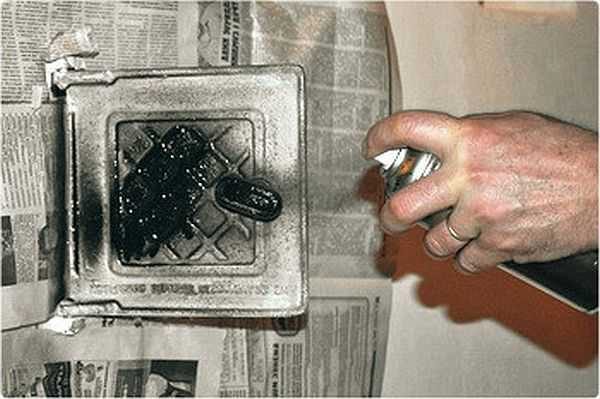
If you paint the metal parts of a brick oven, the rest of the surface must be protected
If you need to paint the metal parts of the stove, choose a composition from those that are suitable for metal stoves with temperatures of 800 degrees and above. First, the parts must be cleaned of old paint, dirt and rust to bare metal. Then cover the surface around the door (they are most often painted) with paper (secure with masking tape) and you can paint.
Areas of application
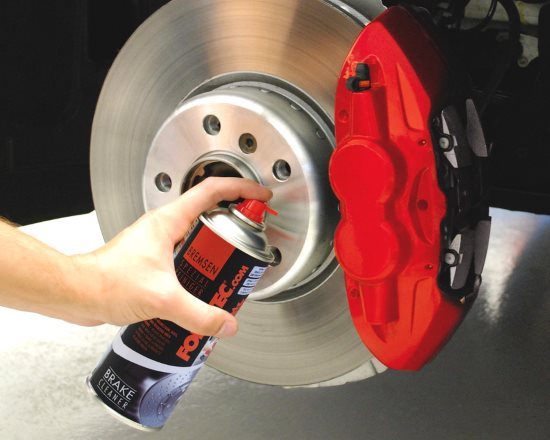
Consequently, this product is actively used for painting objects in saunas, ovens, steam rooms, and drying chambers (fireproof silicone paints are relevant, which can withstand temperatures up to +600, and some up to +1000 ℃).
These aerosols are also used to paint elements of heating systems, fireplaces, barbecues and barbecues. But the scope of application of heat-resistant paints in spray cans does not end there.
Thermal paints are widely used in the automotive industry for the treatment of mufflers, brake calipers, and engines.
Most often, aerosol thermal paints are used on metal products. The reason for this is the heat transfer of the metal (it heats up quickly). But many brands are also suitable for painting brick and stone masonry stoves.
When choosing paint for specific purposes, you should take into account the surface material that is recommended for coating. Do not forget that if you need to paint a stove in a bathhouse or sauna, you must purchase an aerosol that can withstand high humidity.
Heat-resistant paint for barbecue
The cost of heat-resistant paints and varnishes is largely determined by their composition, which affects the heat resistance of the paint. Recently, paintwork materials created on an organosilicon basis have become increasingly popular. They are used not only for painting fireplaces and stoves, but also for processing heating devices, heat exchange equipment, barbecues and much more.
Aluminum powder, which can withstand temperatures up to 600˚C, also helps to significantly increase the heat resistance of the paintwork. This composition is excellent for painting barbecues, not only protecting it from corrosive processes, but also giving it an excellent appearance.
Heat-resistant coatings not only make the appearance of the structure more attractive, but also significantly extend its service life. This is achieved due to the fact that the paint coating evenly distributes the temperature over the entire painted surface, which prevents overheating of the stove or barbecue.
This is especially true for metal structures in which welds tend to melt from prolonged exposure to high temperatures. Heat-resistant compounds not only maintain the vapor permeability of the surface, but also protect against humidity and oil products released when exposed to high temperatures.
Advantages and disadvantages
Spray paints have both advantages and disadvantages that you need to be aware of that may influence your final choice.
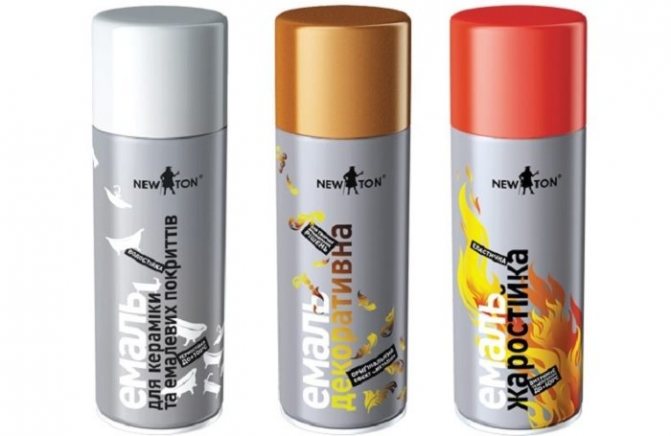
The advantages include:
- ease of use of the aerosol in a can, since the composition is already ready for application to the surface and does not require any additional preparation steps;
- when painting, it easily copes with hard-to-reach areas;
- does not require additional tools and devices, except for a mask for the worker;
- dries in a short period of time and is not exposed to direct sunlight;
- the aerosol has good adhesion properties;
- the remaining composition in the can does not dry out;
- heat-resistant paint is often odorless or light, not concentrated;
- allows you to paint in several shades at the same time with a smooth transition between colors.
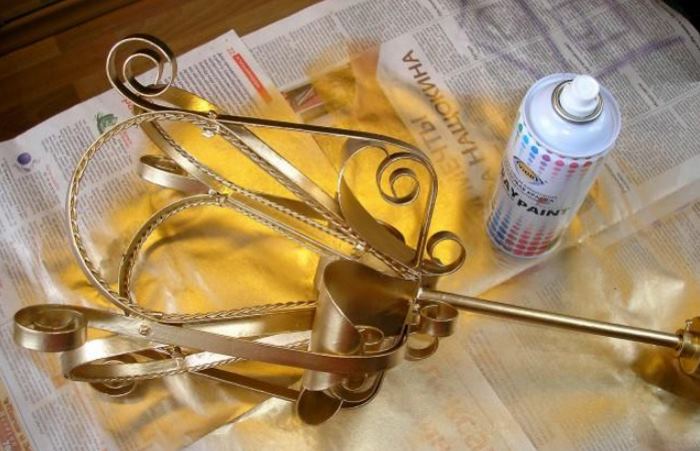
In addition to the advantages, there are also disadvantages that cannot be called too significant. So, when purchasing this product, you should pay attention to the inability to mix different colors.
When applying an aerosol without proper experience, you must be prepared for the appearance of drips. To get straight lines, use stencils. Paints in spray cans do not have the ability to change the consistency of the composition.
For painting metal surfaces that are susceptible to high temperature conditions, the use of heat-resistant paints in cylinders is advisable.
Working with aerosol outdoors is not always convenient; you need to control weather conditions and gusts of wind, which, when spraying paint, can scatter it in different directions.
When compared with similar products in another form of release, the price is justified by the quality of the coating and durability of use. This product is famous for its good adhesion to the surface being coated.
By following the instructions and applying the paint in accordance with all the rules, you will ensure a service life of at least ten years.
Organosilicon paint "Siltek"
Since 1977, in the laboratory of the Institute of Silicate Chemistry named after I.V. Grebenshchikov RAS (later JSC "SilTEK" since 1922) developed organosilicate paint "Siltek" - this is a special universal decorative and protective coating for:— protection of ceramics and silicate materials, structures of fuel pipelines, gas and chimneys, structural elements made of wood from atmospheric, mechanical and chemical influences;
— protection of metal structures from corrosion and oxidation operating in extremely difficult conditions;
— imparting wear-resistant and abrasion-resistant properties to painted surfaces;
— imparting fire- and heat-resistant properties to painted surfaces; — giving surfaces high electrical insulating properties;
— installation of industrial floor coverings that are not subject to peeling when exposed to variable (“negative-positive”) temperatures.
Coatings made with Siltek paint effectively protect structures from destructive influences at temperatures ranging from -70 oC to + 800 oC. (When the coating is cured at ambient temperature, the heat resistance is 230 - 300 oC. To achieve heat resistance above 300 oC, it is necessary to perform hot curing).
Materials coated with the Siltek composition do not retain or accumulate dust and dirt, and are self-cleaning. The appearance of the coating remains unchanged for many years.
Siltek paint is recommended for use by SPKTB Mosgidrostal and approved by Trest Gidromontazh OJSC.
Main Applications:
Construction, mechanical engineering, shipbuilding, carriage building, chemical and oil industry, nuclear energy (radiation resistance), hydroelectric power stations, state district power stations, protection of port structures, wear-resistant floor coverings, wear-resistant marking coatings, anti-corrosion protection of metal structures operating in extremely difficult conditions, gas and chimneys , pipelines, hydraulic structures, bridges and their supports, high-voltage power lines (power lines), microprocessor technology, facade finishing, including in winter.
Main characteristics:
Indicator name
| Norm | |
| Application temperature | -40 оС – +40 оС |
| Drying time to degree 3, at 20 °C, no more | 20 minutes. |
| Solvent | Toluene |
| Ability to be applied to surfaces | Spreads well and forms a self-leveling surface layer |
| Covering power g/m2 | 250-300 |
| Thickness of one layer, microns | 50 |
| Appearance of the coating | After curing, the surface is flat, smooth, matte, without bubbles or cracks. |
| Impact strength V-2 kg/cm2 | 35 |
| Coating adhesion, mm | 1 |
| Hardness according to MO-3 device, arb. units - in 24 hours — in 48 hours — after 7 days | 0,15 0,22 0,45 |
| Electric strength, kV/mm, not less | 10 |
| Specific volume resistivity, Ohm, not less — at 20 оС — at 200 оС - after exposure to humidity conditions of 95-98% for 24 hours | 1.5 x 1013 3.6 x 1011 5.0 x 1012 |
| Water saturation after 72 hours in water, % | 0 |
| Resistance (fire and fire safety) to temperatures, °C | -70 — +600; -70 — +800 |
| Toxicological safety | Class according to GOST 12.1.0076 – 3rd |
| Wear resistance (sand), kg/mm2 | 300-500 |
Basic properties:
Siltek paint, developed specifically for use in aggressive environments, compares favorably with similar special coatings in a number of important parameters and low price; its use is certainly promising for a wide range of objects.
When applied to metal structures, Siltek paint does not require priming coatings (it primes itself).
Industrial floor coatings made with Siltek paint are not subject to peeling, which is typical for most epoxy self-leveling floors when subjected to repeated exposure to variable (“negative-positive”) temperatures.
The use of Siltek paint for coating surfaces operating in damp environments or in water makes it possible to remove biological fouling without destroying the paint coating.
All paint components are made in Russia.
The paint is abrasion-resistant and abrasion-resistant.
The durability of coatings made with Siltek paint has been tested by many years of operation in extreme conditions. Positive results of operation are documented.
In accordance with the order, Siltek color paint is supplied: “ball” in different shades, red, yellow, green, beige, black, white, brown, blue, etc.
Siltek paint is certified according to Russian standards and norms.
The guaranteed shelf life of Siltek paint in tightly closed manufacturer's containers is at least 12 months from the date of manufacture.
Packaging – 25kg bucket
Organosilicon silicone paint (OSK-2) "Siltek - 2"
Universal water-repellent impregnations "GSK" (for Siltek paint)
DIY heat-resistant paint
Currently, there are quite a few proven heat-resistant compounds that you can make with your own hands and paint a metal stove or barbecue. In principle, this is one option - add aluminum powder to liquid glass and mix well, the result is heat-resistant silver-colored paint.
Before applying heat-resistant paint, like any other paint, the surface must first be prepared. Clean off any debris, remove rust and old coating with sandpaper, degrease, and only after these procedures can you start painting. Heat-resistant paint can be applied with a paint brush, roller or spray.
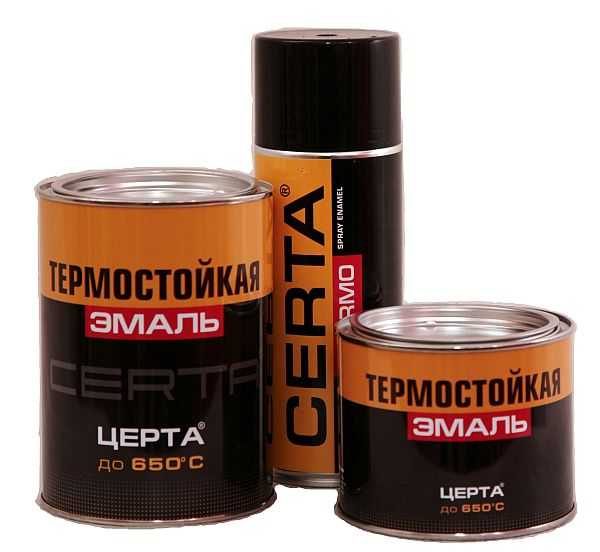
Heat-resistant paints can be applied over a wide temperature range from 40˚C to -15˚C, but it is necessary that the air humidity is within normal limits. It is best to apply heat-resistant paint and varnish in several layers. The second layer should be applied only after the first has completely dried.
And it is worth noting once again that treating the surfaces of a stove, fireplace or barbecue with heat-resistant paint allows you not only to give them a presentable appearance, but also, thanks to the protective paint coating, to extend their service life. And the choice of paint based on the manufacturer - domestic or foreign - depends only on your personal preferences and financial capabilities, especially since some Russian companies produce paints and varnishes that are in no way inferior to their Western counterparts.
